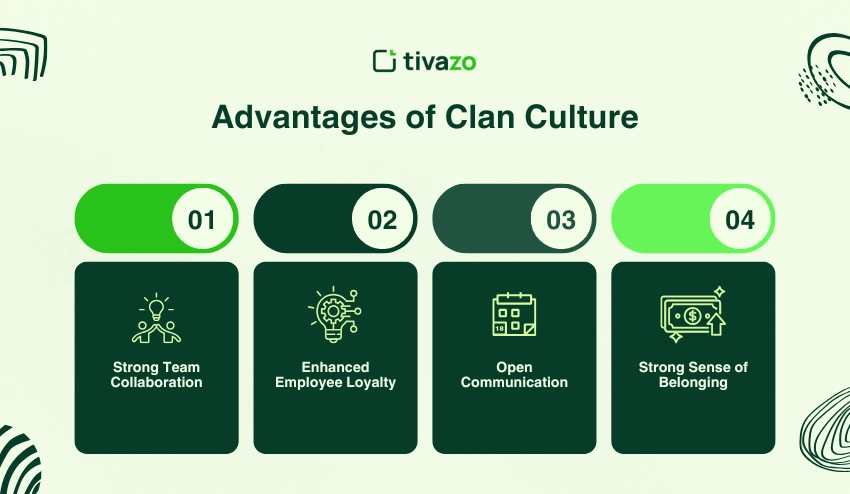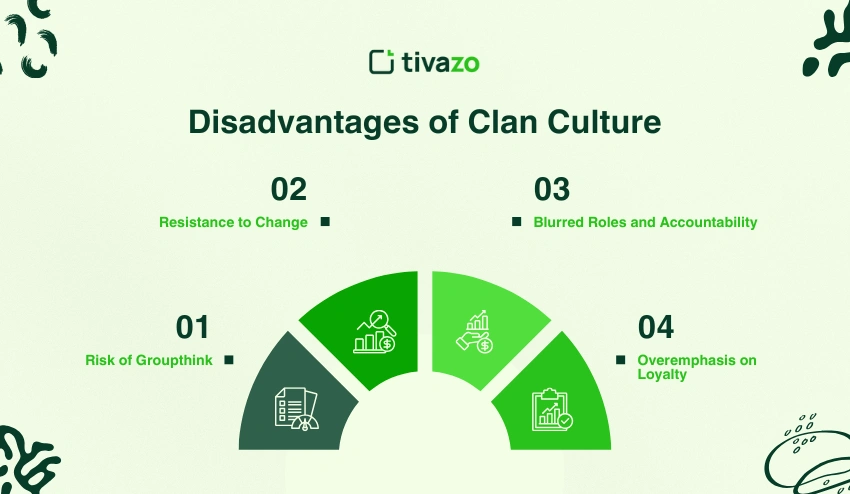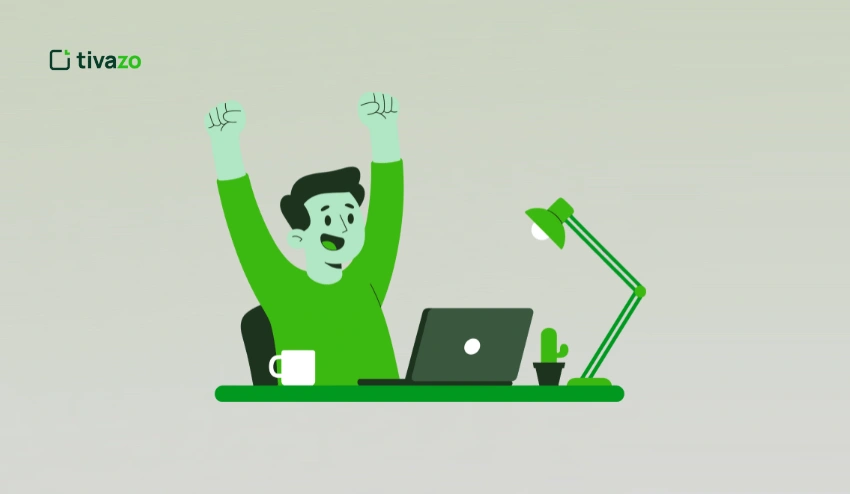Imagine working in a place that feels less like a corporate office and more like a supportive family. That is the nature of the clan culture, a based environment where cooperation, trust, and open communication are put to the fore.
Unlike the rigid structures, which are rule-oriented or profit-oriented, the clan culture is supported by employee loyalty, mutual company objectives, and the family-type workplace culture. Leaders are more mentors than bosses as they foster participative leadership and make people feel a strong sense of belonging.
People first is no longer the only way to get happier teams; it also enhances employee engagement, fosters a cooperative workplace culture, and enables organizations to respond with nimbleness. In a world where culture can either make or break success, an insight into how the culture of a clan can influence the workplace explains why it is one of the best types of organizational culture nowadays.
What is Clan Culture?
Clan culture is an organizational culture type that prioritizes people over processes, creating a team-oriented and family-like workplace environment. In companies across the US or other places, clan culture encourages collaboration, open communication, and employee loyalty, helping local businesses build strong, motivated teams.
The clan culture is unlike hierarchical or market cultures, which emphasize participative leadership and shared company values, which make employees feel that they belong to the company. Engaging and building trust with employees and commitment in the long-term makes this people-first approach the best fit in organizations that want to survive in the competitive urban markets.
To local businesses, the adoption of a clan culture not only increases productivity but also boosts the reputation of a firm as a good and human working environment.
What is a Clan in Native American Culture
Within the Native American culture, a clan is defined as a collection of families that is connected by both blood ties, traditions, and values, creating a close and supportive community. Similar to a clan culture in contemporary workplaces, these clans value loyalty, trust, and cooperation, which have formed a strong sense of identity and belonging amongst members of these clans.
Every clan tends to have its symbol, tales, and functions that imply the establishment of a team-oriented relationship and a family-like atmosphere in which the elder members mentor and impart knowledge to younger ones. Such a strategy supports the value of human-centered values, participative leadership, and supportive networks, which are similar to the way the clan culture operates in organizations nowadays.
Knowing the origins of clan culture in Native American societies, we learn that cooperation, common interests, and good personal relations may empower any organisation, cultural groups, to contemporary workplaces.
What is Clan Mentality?
Clan mentality refers to a mindset where individuals prioritize the needs, goals, and loyalty of their group over individual interests. It mirrors the principles of clan culture, emphasizing teamwork, trust, and collaboration. People with a clan mentality naturally support one another, share responsibilities, and work toward shared company goals or common objectives.
Both in the workplace and within communities, the mentality leads to a family-like environment where communication is open, employees are involved, and good interpersonal relationships are promoted. On the one hand, it facilitates loyalty and unity; on the other hand, a clan mentality may develop a resistance to foreign ideas unless it is accompanied by flexibility and innovation.
The concept of clan mentality assists leaders in developing a people-centric organizational culture, enhancing employee loyalty, and creating an environment that is really supportive and cooperative at work.
What is Clan Behavior?
Clan behavior is a behavior that is used in a group or an organization that represents the mindset of a clan culture. It focuses on teamwork, collaboration, and loyalty, where members of the team support one another and strive towards a common goal. Clan behavior among employees is usually characterized by open communication, trust, and commitment, forming a family-like work environment that fosters interaction and team spirit.
How to Build a Clan Culture?
The creation of a clan culture is a deliberate effort that needs to focus on people, teamwork, and values. Begin by encouraging free communication and participative leadership where employees feel that they are being listened to and included in decision-making. Promoting teamwork, mentorship, and engagement among employees enhances trust, loyalty, and a family-like workplace atmosphere.
Advantages of Clan Culture
A clan culture provides an organization with a work environment in which individuals feel valued, supported, and connected, which results in increased employee satisfaction and engagement. Organizations can create a highly motivated and unified workforce by prioritizing team-oriented behaviour, loyalty, and free flow of information.

Strong Team Collaboration
The employees in a clan culture have harmonized work and knowledge sharing, and help each other. Such a team-based workplace fosters mentorship, participatory leadership, and collaboration to find solutions to issues, as opposed to putting the pressure on individuals.
The outcome will be a very cohesive work team where everybody is contributing towards a communal company objective. Good cooperation also enhances productivity and the creation of a working atmosphere characterized by a family approach, which makes employees feel a sense of belonging and meaning.
Enhanced Employee Loyalty
Clan culture is more focused on trust, recognition, and a human-oriented management system, which in effect enhances the loyalty of employees. Since employees will be supported and appreciated, the chances of them leaving will diminish, and long-term stability will increase.
The presence of loyal teams also increases the interest in the company activities, which favors the culture of the organization that should be people-oriented. In the long run, this loyalty would lead to better relationships, morale, and a business that is stronger.
Open Communication
A clan culture creates open workplace communication, and ideas and feedback are freely shared between leaders and employees in an organization. Open communication promotes participative decision-making where team members do not feel ignored.
Not only will this approach help to avoid misunderstandings, but it will also help to increase the engagement and trust of employees, which will strengthen the collaborative and supportive background of the clan culture.
Strong Sense of Belonging
One of the characteristics of a clan culture is the family atmosphere in which it is organized. The staff feels a strong sense of belonging, personal and professional, set with company values.
Such a sense of belonging influences people to deliver their best towards the organisation, which enhances team spirit and reinforces organisational culture. Through the feeling of belonging to a greater community, productivity and morale are bound to rise among the employees.
All in all, the benefits of being a clan-based culture, including excellent teamwork and team allegiance, as well as free flow of communication and inclusion, make the workplace a success and a people-focused one. These human-centered values and a positive and teamwork atmosphere within the workplace can ensure that organizations work towards success in the long run, as well as retain employees who remain engaged and motivated.
Disadvantages of Clan Culture
Although the climate of collaboration and loyalty is inculcated in a clan culture, there are challenges that may emerge until it is balanced with structure and innovation. Excessive focus on relationships and agreement can occasionally result in sluggish choices and decreased flexibility within a time-sensitive context.

Risk of Groupthink
High team cohesion and emphasis on harmony in a clan culture may at times cause groupthink, where employees are afraid to raise challenging ideas. This may slow innovation and avoid critical problems being handled in time.
It might also suffocate free communication and varied opinion, and therefore, the organization may not respond well to the emerging market conditions or external adversities because of groupthink.
Resistance to Change
The members of a clan culture have a tendency to value stability, trust, and relationships. Although this generates a sense of loyalty, it may lead to a resistance to change in an organization or new processes that upset the old family-like workplace culture.
Such resistance may delay the implementation of innovation and restrict the responsiveness of the organization, and this may affect its competitiveness over time.
Blurred Roles and Accountability
The very collaborative people-first culture may lead to a loss of roles on certain occasions when it is not clear who is in charge of particular duties. This can result in inefficiency and even a consensus-driven decision-making process.
The lack of role definition can make employees confused, and considering the decreased engagement of the whole employee and slowed workflow, it can influence productivity rates in the long term.
Overemphasis on Loyalty
Although one of the benefits of the clan culture is loyalty, too much emphasis on relations can lead to favoritism or a lack of action when performance is lower. Leaders can be afraid to make stern decisions as a way of preserving peace.
This may diminish participative leadership, lower accountability, which may have an impact on team performance and the organizational results.
Despite the many advantages that come with a clan culture, such as a trusting culture, teamwork, and a friendly working environment, it should be noted that this culture also has its share of disadvantages. Striking the balance between loyalty and harmony, on the one hand, with the clear roles, accountability, and openness to change, on the other, will provide organizations with the benefits of a people-centered culture without compromising efficiency and innovation.
Clan Culture Characteristics
A clan culture is characterised by firm emphasis on people, relationships, and common values. This culture places emphasis on teamwork, loyalty, and openness in communication, whereby the organization has a family-like work culture in which workers feel nurtured, involved, and inspired.
Team-Oriented Environment
A team-based environment is one of the main attributes of the clan culture. The workers are cooperative towards each other, as they help each other to accomplish the common targets of the company, which makes the employees engaged and respectful.
This practice promotes mentorship and team-building, and decision-making, which makes the workplace culture supportive and human-friendly. Problem-solving together with teams is also made possible, which makes them more cohesive and trustworthy.
Participative Leadership
The culture of a clan focuses on participative leadership, whereby the leaders are seen as mentors and not as authoritative ones. Managers engage the employees in the decision-making process and consider their contributions, encouraging openness and inclusiveness in communication.
The leadership style enhances the loyalty of employees and creates a people-first organizational culture, in which employees believe that their input is important and their voices are heard.
Strong Sense of Belonging
One of the main peculiarities of the clan culture is the sense of belonging that it produces. The workers see themselves as being in a tight-knit community, which increases motivation and dedication.
The resulting feeling of belongingness matches individual and company ambitions, strengthening the cohesion, trust, and general morale of the team. It also promotes long-term employee engagement and loyalty.
Emphasis on Loyalty and Trust
The culture of the clan is based on loyalty and trust. The employees depend on each other, distribute duties, and assist others, which leads to collaborative behavior at the workplace.
This also applies to leadership, where trust brings out an open and human environment where employees are comfortable sharing ideas, taking risks, and helping in the success of an organization.
Realization of the main peculiarities of the clan culture: the collaboration and participative leadership, the loyalty, trust, and belonging to the individual parts of the organization make it possible to create an environment of support and mutual cooperation within the organization. With the development of these qualities, the companies can increase their employee engagement, productivity, and long-term success without losing a people-first organizational culture.
Clan Culture vs Market Culture
| Aspect | Clan Culture | Market Culture |
| Focus | People-first, teamwork, and relationships | Results, competition, and achieving targets |
| Workplace Environment | Family-like, supportive, and collaborative | Goal-driven, performance-oriented, and competitive |
| Leadership Style | Participative, mentoring, and inclusive | Directive, performance-focused, and outcome-driven |
| Employee Engagement | High due to trust, loyalty, and open communication | High if aligned with rewards, recognition, and performance incentives |
| Decision-Making | Consensus-driven, collaborative, and transparent | Top-down, fast-paced, and efficiency-focused |
| Key Strengths | Employee loyalty, strong collaboration, sense of belonging | Productivity, competitiveness, and achieving measurable results |
| Potential Weaknesses | Risk of groupthink, slower decision-making | Lower employee engagement, less focus on team cohesion |
| Organizational Goals | Long-term employee satisfaction and cohesion | Market share, profitability, and growth metrics |
Clan Culture Examples
Example 1: Google’s Team-Oriented Environment
Google is stoutly known to have a clan culture which has created a family culture of workplace where teamworking, confidence, and open communication are central. The organizational culture is people-first as employees are taught to engage in decision-making, exchange ideas, and help each other.

High morale and productivity in Google are assisted by this environment of teamwork and focus on employee engagement, mentorship, and loyalty. The company has an environment that supports and works well with the rest of the personnel, which is very encouraging, as it focuses on relationships and human-centered management, attracting the best talent globally.
Example 2: Zappos’ Employee-Centric Culture
Zappos uses clan culture as a company with a heavy emphasis on work teams, loyalty, and participative leadership. The company fosters a favorable work environment that helps employees feel part of the company, and they strive to work towards achieving the common objectives of the company.
Through fostering open communication, trust, and a family-like environment, Zappos enhances employee engagement and cooperation. This people-focused strategy is what makes employees not only productive but also loyal to the people-first organizational culture, which prompts success in the long term.
Conclusion
A shift to a clan culture can make workplaces people-friendly, collaborative, and teamwork, trust, and loyalty are enhanced. Through an atmosphere of openness, participative leadership, and a family-like working environment, organizations encourage employee involvement, a sense of belonging, as well as human management. Although such obstacles as groupthink or resistance to change may occur, harmony and accountability are the key issues to success in the long term.
Google and Zappos demonstrate that fostering teamwork at the workplace, mentorship, and the pursuit of a common corporate vision not only enable organizations to increase employee loyalty but also motivate, create innovations, and grow sustainably, which is why clan culture is a major element in the creation of a motivated and unified workforce.




